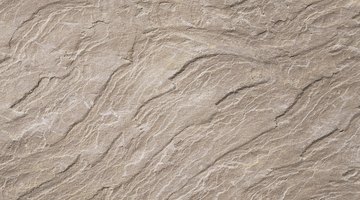What Is the Difference Between Limestone & Calcite?
Calcite is a mineral that occurs in the natural geological processes of the Earth. Calcite is a form of calcium carbonate, a type of calcium salt oxide with three atoms of oxygen bonded to one atom of calcium. Calcite binds with other compounds to create limestone which is used in construction.

When using these substances as building materials, the differences between calcite and limestone become clear.
What Is Calcite?
The calcite form of calcium carbonate forms in all types of rock, according to the Minerals-N-More site. Often, some of the calcium component is replaced by small amounts of Iron, magnesium or manganese. It is found in marble, limestone, sandstone and shale. Calcite is frequently phosphorescent in nature. When the rock is struck in a darkened room, the pieces will glow. Calcite is generally white, but impurities can create a variety of colors within the material.
How Is Calcite Used?
Calcite is used in its primary mineral form as a light abrasive in cleaning agents, as a whitening agent and in metallurgical processes. Calcite was once used for gun sites for armaments during the second World War. Calcite comes in a wide range of crystalline structures, which make them of interest to gems collectors. Calcite is found throughout the world in such places as England, Germany, Brazil, Mexico, Russia and a number of regions in the United States.
What Is Limestone?
Limestone is another form of calcium carbonate. It generally contains 50 percent of calcite along with other minerals such as quartz, clay, pyrite or other materials. Limestone tends to form in calm, shallow, watery environments where marine animals live. These animals contribute their skeletons and waste products to the rock. Fossils are often found in limestone-type rock formations.
How Is Limestone Used?
Limestone’s special properties make it useful for a wide variety of applications in farming, metallurgy and manufacturing. Limestone rock is relatively soft and easy to cut into blocks for construction. Landmarks, roadbeds, buildings and landscape features are often made of limestone, according to the WhiteStarMining site. Limestone is not a good material to use in areas with acid rain, however, as the acid can pit and wear away the mineral surface. Pulverized lime is used in farming and horticulture to raise the pH level of soil to make it more alkaline for the healthy growth of certain types of plants. Limestone is also used in industrial processes as an abrasive, in paint and paper manufacturing as a whitener, and in food processing and pharmaceuticals.
The Drip Cap
- Calcite is a mineral that occurs in the natural geological processes of the Earth.
- Calcite is a form of calcium carbonate, a type of calcium salt oxide with three atoms of oxygen bonded to one atom of calcium.
- Often, some of the calcium component is replaced by small amounts of Iron, magnesium or manganese.
- Calcite is found throughout the world in such places as England, Germany, Brazil, Mexico, Russia and a number of regions in the United States.
- Fossils are often found in limestone-type rock formations.
- Limestone is not a good material to use in areas with acid rain, however, as the acid can pit and wear away the mineral surface.
References
Photo Credits
- Brand X Pictures/Brand X Pictures/Getty Images
- Brand X Pictures/Brand X Pictures/Getty Images
More Articles



